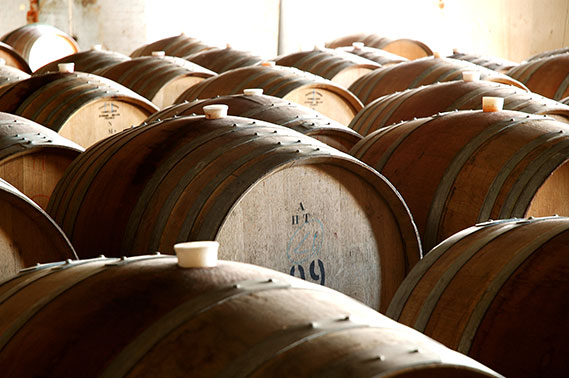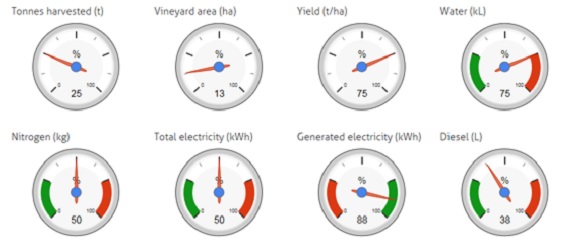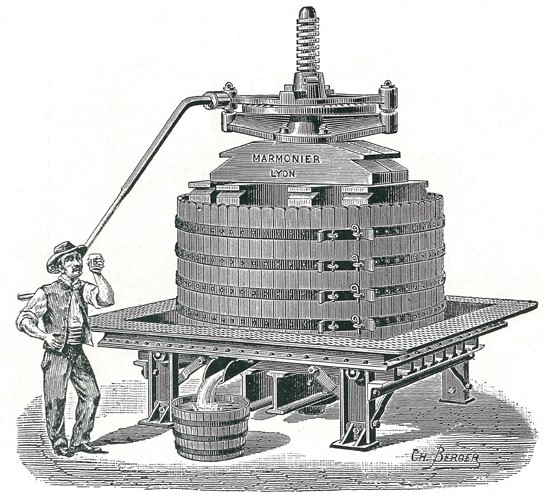Time for a spring MLF check-up?
Entwine – new benchmarking data available
Drones, frost, flotation and making lower alcohol wines
Yeast matchmaking delivers low VA breeds
Looking to the past and future of grape pressing technology
Two government reviews out for comment
Don’t miss your chance to attend tasting courses in November
Order the latest AWRI staff publications online
Time for a spring MLF check-up?
It’s been a cold winter – but September is here and this is a good time to take stock of wines that have been going through maloloactic fermentation (MLF) during the colder months. The start of spring can be a critical opportunity to act to prevent wine spoilage because wines that are slow to complete MLF have low levels of SO2 and are therefore vulnerable to spoilage organisms.
If analysis shows that wines are progressing through MLF very slowly or VA levels are creeping up, then it’s time to take action – warming or re-seeding might be required. Key steps for preparing a MLF starter culture can be found in this protocol. Where barrels of wine have completed MLF, it’s important not to leave them with low SO2 levels – racking and SO2 additions should be carried out as soon as possible after MLF completes to minimise the risk of spoilage.
For more information on managing slow MLFs, please contact the helpdesk on helpdesk@awri.com.au or 08 8313 6600.
Entwine moves to the AWRI
The recent change in management of Entwine Australia, the Australian wine industry’s national environmental assurance program, was well timed to coincide with membership renewals and collection of the annual environmental benchmarking data. This year, for the first time, all members will receive a personalised benchmarking report to assist them to identify areas of environment expertise and also opportunities for improvement. The new Entwine Australian Wine Carbon Calculator (AWCC) and benchmarking tool convert the raw environmental indicators provided by members into a ‘dashboard’ display which shows the performance ranking of each member. The displays can be modified to compare an individual member’s data against others in their region, the data of all members nationally or against other vineyards or wineries of the same size. This enables a grower to compare their environmental performance to that of others in their region and elsewhere.
The next stage of this project, due for release in October, is to expand the reporting of regional benchmarks to assist growers to effectively identify opportunities to reduce greenhouse emissions and increase production efficiency. These results will be extended to industry in a series of 27 workshops being held across all regions in the next ten months. Workshops will be publicised through regional associations, email notifications, the AWRI website, the Australian Grape and Wine Events Calendar and Twitter.
The upgrades to the AWCC have been made available through the Extension and Outreach project which is funded by the Australian Government. More information about Entwine and the Australian Wine Carbon Calculator can be accessed on the AWRI website here or check out the other resources from the Extension and Outreach project here.
Drones, frost, flotation and making lower alcohol wines
What do these topics have in common? They are all coming up soon in the AWRI webinar program! Each Thursday morning at 11.30 am Australian Central Standard Time (Adelaide, GMT+9:30), you can tune into a webinar from your desktop. You will hear the presenter’s voice, see their slides and can ask questions after the presentation. A full list of this year’s topics and links to register can be found here. If you have any questions or need help, contact the information services team on 08 8313 6600 or infoservices@awri.com.au.
Yeast matchmaking delivers low VA breeds
Who doesn’t enjoy the exquisite taste of a ‘sticky’? Botrytis wine styles are popular with consumers, but wine yeast can find them challenging to ferment due to the very high sugar concentrations in botrytised juice. Robust commercial strains of Saccharomyces cerevisiae are generally the yeast of choice for such products; however, even these yeasts can find the conditions difficult and, as a result, the wines can suffer from elevated levels of volatile acidity.
To address this issue, researchers at the AWRI have used traditional yeast breeding techniques to produce interspecific hybrids between a robust S. cerevisiae wine yeast and S. uvarum (the yeast previously known as Saccharomyces bayanus that is known for its ability to produce wines with lower acetic acid levels). The hybrid progeny display the targeted properties from each parent: robust fermentation in botrytised Riesling juice and low volatile acidity production.
Two S. cerevisiae x S. uvarum hybrid strains (AWRI 1571 and AWRI 1572) show suitability for use in producing wine styles that are traditionally troubled by excessive volatile acidity levels. While these strains are not yet available for winemakers as active dried yeast products, they can be accessed through the AWRI Wine Microorganism Culture Collection (culture@awri.com.au).
A report on this work entitled ‘Designing and creating Saccharomyces interspecific hybrids for improved, industry relevant, phenotypes’ was recently published in the peer-reviewed journal Applied Microbiology and Biotechnologyand is available from the AWRI library.
Looking to the past and future of grape pressing technology
AWRI Senior Engineer Simon Nordestgaard recently shared his in-depth knowledge of grape pressing technology (past, present and future) at the Winery Engineering Association Conference in the Barossa. Simon studied grape pressing as part of his PhD studies at the University of Adelaide. His presentation went back to presses used in Ancient Egypt, Greece and Rome, through technological developments of the 19th and 20th centuries, to present day and beyond.
Simon has also recently authored two articles on the history of grape presses for Australian & New Zealand Grapegrower & Winemaker. The first article, which looks at the history of batch press technologies, was published in the August edition. The second article, which focuses on continuous presses and some future perspectives, will come out shortly in the September edition.
For those who’d like to hear more about this subject, Simon will be repeating the presentation he gave at the WEA conference on 9 September in Adelaide at an event hosted by Engineers Australia, the Institution of Chemical Engineers, the Royal Australian Chemical Institute and the Australian Institute of Food Science and Technology. For more information, or to register, visit the event webpage.
Seminar and workshop update
The AWRI Grape and Wine Roadshow team has been busy over the past few months delivering seminars and workshops across Australia. Seminars have recently been presented in: Rutherglen, Bendigo, Avoca, McLaren Vale, Canberra, Orange, Mudgee and Clare.
The next roadshow seminar will be in the Barossa Valley on Tuesday, 8 September and the ‘Adapting to Difficult Vintages’ workshop will be presented in Mudgee, Orange and Canberra in late October. In addition, ‘Opportunities in a new climate’ workshops will be delivered across SA over the next few months, presenting the latest on climate change mitigation and the recently acquired Entwine Australia program.
For more information on upcoming seminars and workshops, visit the AWRI events calendar, contact your local association or contact the events team at the AWRI.
Two government reviews out for comment
Two government reviews relevant to the grape and wine sector have recently been announced, where comments or submissions can be made by interested parties. The first is an inquiry into agricultural innovation and the second is a review of Safe Food Australia – the explanatory guide to food safety standards in the Australia New Zealand Food Standards Code.
- The House of Representatives Standing Committee on Agriculture and Industry is conducting an inquiry into agricultural innovation.
The Committee will inquire into and report on the role of technology in increasing agricultural productivity in Australia. The inquiry will have particular regard to:- improvements in the efficiency of agricultural practices due to new technology, and the scope for further improvements;
- emerging technology relevant to the agricultural sector, in areas including but not limited to telecommunications, remote monitoring and drones, plant genomics, and agricultural chemicals; and
- barriers to the adoption of emerging technology.
The Committee has set Friday 25 September 2015 as the closing date for the receipt of submissions. Details on how to make a submission are available here.
- Food Standards Australia New Zealand (FSANZ) has released a consultation paper on a review of Safe Food Australia.
Safe Food Australia is an explanatory guide to the food safety standards in Chapter 3 of the Australia New Zealand Food Standards Code, which is used as a practical tool, by both industry and regulators, to help understand and implement safe food handling practices.
Food Standards Australia New Zealand (FSANZ) is currently reviewing Safe Food Australia to address current food safety issues and trends, provide new guidance for mobile vendors and home-based vendors and to update the evidence referenced in the guide. FSANZ is also considering the format and delivery of the publication, for example by providing it in mobile friendly formats.
More information is available here and comments can be provided through submissions@foodstandards.gov.au.
Don’t miss your chance to attend tasting courses in November
The AWRI will hold two Advanced Wine Assessment Courses in November. The ballot for places will be held shortly, so register your details if you’re not already on the list. Anyone who has registered previously will be automatically entered into the ballot.
The AWACs will be followed on Friday 20 November by a return of the one-day course ‘Wine show judging – an insider’s view of panel tastings’ which was successfully held for the first time in July. This course gives small groups of participants the opportunity to taste under wine show conditions with guidance from three experienced wine show chairs (Sam Connew, PJ Charteris and David Bicknell). Places in this course are limited to 15 participants – reserve your place now!
For more information on the AWRI’s tasting courses, please contact the events team on 08 8313 6600 or events@awri.com.au.
Order the latest AWRI staff publications online
Accessing the latest AWRI publications is easy. Visit the AWRI Publications web page to:
- View the 10 most recent AWRI staff publications and order the articles online from the AWRI Library
- Search the staff publications database
- Read the full-text of ‘Technical Notes’ from Technical Review (PDF format)
- Read the full-text of ‘AWRI reports’ published in Wine & Viticulture Journal (PDF format).
A full list of AWRI publications published since the last eNews is included below:
1725 Nordestgaard, S. Developments in destemming and sorting technology. Part two: Harvester-mounted destemmers and sorters. Aust. N.Z. Grapegrower Winemaker (618): 27-29; 2015.
1726 Petrie, P. Ask the AWRI: Bunch stem necrosis. Aust. N.Z. Grapegrower Winemaker (618): p. 36; 2015.
1727 Sparrow, A.M., Dambergs, R.G., Bindon, K.A., Smith, P.A., Close, D.C. Interaction of grape skin, seed, and pulp on tannin and anthocyanin extraction in Pinot noir wines. Am. J. Enol. Vitic. doi: 10.5344/ajev.2015.15022; 2015.
1728 Coulter, A., Cowey, G., Petrie, P., Essling, M., Holdstock, M., Stockley, C., Simos, C., Johnson, D. Vintage 2015 – observations from the AWRI helpdesk. Wine Vitic. J. 30 (4): 38-40; 2015.
1729 Longbottom, M. Compressed, crushed and crowned. Wine Vitic. J. 30 (4): p. 10; 2015.
1730 Dry, P. Cortese. Wine Vitic. J. 30 (4): p. 60; 2015.
1731 Cordente, A.G., Capone, D.L., Curtin, C.D. Unravelling glutathione conjugate catabolism in Saccharomyces cerevisiae: the role of glutathione/dipeptide transporters and vacuolar function in the release of volatile sulphur compounds 3-mercaptohexan-1-ol and 4-mercapto-4-methylpentan-2-one. Appl. Microbiol. Biotechnol. doi: 10.1007/s00253-015-6833-5; 2015.
1732 Anesi, A., Stocchero, M., Dal Santo, S., Commisso, M., Zenoni, S., Ceoldo, S., Tornielli G.B., Siebert, T.E., Herderich, M., Pezzotti, M. Guzzo, F. Towards a scientific interpretation of the terroir concept: plasticity of the grape berry metabolome. BMC Plant Biology 15 (191): 1-17; 2015.
1733 Zhang, P., Howell, K., Krstic, M., Herderich, M., Barlow, E.W.R., Fuentes, S. Environmental factors and seasonality affect the concentration Rotundone in Vitis Vinifera L. cv. Shiraz wine. PLoS ONE 10 (7): e0133137; 2015.
1734 Nordestgaard, S. The history of wine presses. Part 1: Batch presses. Aust. N.Z. Grapegrower Winemaker (619): 64-71; 2015.
1735 Stockley, C. Ask the AWRI: Wine consumption and heart health. Aust. N.Z. Grapegrower Winemaker (619): p. 72; 2015.
1736 Capone, D.L., Sefton, M.A., Jeffery, D.W., Francis, I.L. Terroir or terpenoid transformation: the origin of 1,8-cineole (eucalyptol) in wine. Hofmann, T., Krautwurst, D., Schieberle, P. (eds.) Proceedings of the 10th Wartburg Symposium on Flavor Chemistry and Biology, Eisenach, Germany, 16-19 April, 2013. Freising, Germany: Deutsche Forschungsanstalt für Lebensmittelchemie: 130-136; 2014.
Acknowledgement
The AWRI acknowledges funding from Australia’s grapegrowers and winemakers through their investment body, Wine Australia, with matching funds from the Australian Government. The AWRI is a member of the Wine Innovation Cluster in Adelaide, South Australia.





